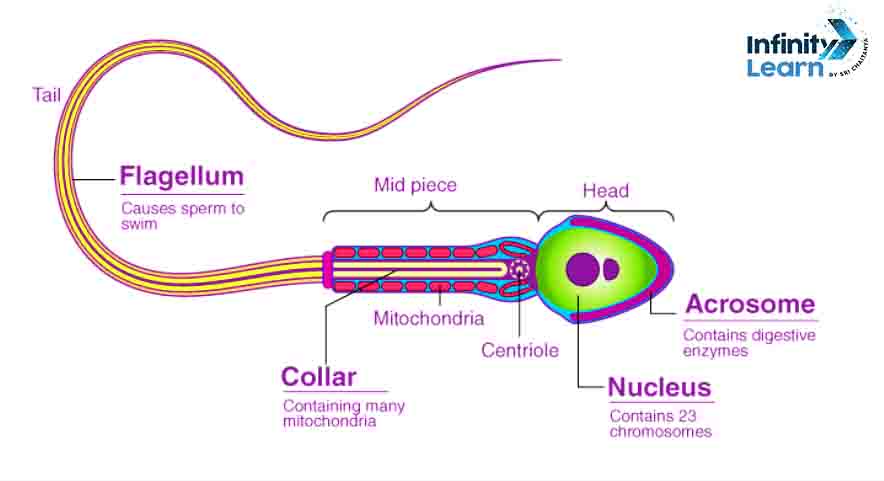Table of Contents
Sperm, or spermatozoon, is the male reproductive cell responsible for fertilizing the female egg (ovum) to create a zygote, which eventually develops into an embryo.
What is Sperm?
Sperm is a specialized, motile cell produced in the male reproductive organs (testes) through a process called spermatogenesis. It is designed to deliver genetic material to the egg during reproduction.
Structure Of Human Sperm Diagram

Structure and Function of Sperm
Below are the Structure and function of Sperm-
Structure of Human Sperm
1. Head
The head of the sperm is the most critical part in the fertilization process. It contains the nucleus, which houses the sperm’s genetic material (DNA). This genetic material is a compact, highly organized structure that carries half of the genetic information required to create a new organism.
The head is also equipped with the acrosome, a cap-like structure at its tip. The acrosome is filled with enzymes necessary for the sperm to penetrate the outer layers of the egg (oocyte) during fertilization. These enzymes help the sperm to break through the zona pellucida, a protective barrier surrounding the egg, facilitating the fusion of the sperm and egg membranes.
2. Midpiece
The midpiece of the sperm is crucial for providing the energy needed for the sperm’s motility. It is densely packed with mitochondria, the cell organelles responsible for generating ATP (adenosine triphosphate), the primary energy currency of the cell. The ATP produced by these mitochondria fuels the flagellum (tail), allowing the sperm to swim and move through the female reproductive tract. The midpiece’s structure ensures that the sperm has enough energy reserves to reach and fertilize the egg.
3. Tail (Flagellum)
The tail, or flagellum, is the longest part of the sperm and is essential for its motility. It is a whip-like structure that propels the sperm forward in a swimming motion. The tail’s movement is powered by microtubules arranged in a specific pattern within the axoneme, which is part of the sperm’s cytoskeleton. This coordinated, whip-like motion allows the sperm to travel through the cervix, uterus, and fallopian tubes to reach the egg. The tail’s structure is optimized for efficient movement, ensuring that the sperm can navigate the female reproductive system effectively.
Function of Sperm
The function of sperm is primarily centered around reproduction, specifically the delivery of genetic material from the male to the female egg. Here’s a detailed breakdown of its functions:
1. Genetic Material Transfer
- The core function of sperm is to carry and transfer genetic material (DNA) from the male to the female egg (ovum). During fertilization, the sperm’s head merges with the egg’s membrane, and its genetic content combines with that of the egg, creating a zygote with a complete set of chromosomes.
2. Fertilization
- The sperm’s head contains an enzyme-filled structure called the acrosome, which releases enzymes that break down the protective layers surrounding the egg. This process allows the sperm to penetrate and enter the egg. After penetrating the egg’s membrane, the sperm’s genetic material fuses with the egg’s genetic material, resulting in the formation of a single-cell zygote that will eventually develop into an embryo.
3. Motility
- Sperm are motile cells with a tail (flagellum) that propels them forward. This motility is essential for traveling through the female reproductive tract to reach the egg. The energy needed for this movement comes from mitochondria in the midpiece of the sperm.
4. Contribution to Embryo Development
- Beyond fertilization, the genetic material provided by the sperm contributes to the developmental blueprint of the embryo. This includes determining the offspring’s genetic traits and characteristics.
5. Interaction with Female Reproductive Tract
- Sperm must adapt to various conditions within the female reproductive tract. The successful navigation of this environment is crucial for reaching the egg, as it involves overcoming physical and biochemical barriers.
FAQs on Structure of Sperm
What is the structure of sperm?
The sperm consists of three main parts: the head, which contains the nucleus with genetic material; the midpiece, which provides energy through mitochondria; and the tail, which propels the sperm.
What are the 4 components of the sperm?
The four components of sperm are the head, midpiece, tail, and acrosome. The head houses genetic material and the acrosome, while the midpiece provides energy, and the tail facilitates movement.
What are the basics of sperm structure and function?
Sperm structure includes a head with DNA and an acrosome for egg penetration, a midpiece with mitochondria for energy, and a tail for motility. Its function is to deliver genetic material to the egg.
What are male eggs called?
Male eggs are not present; instead, males produce sperm, which are the male gametes for reproduction.
What percent of sperm live in 7 days?
Typically, sperm can survive in the female reproductive tract for up to 5 days, not 7.
What is the second name for sperm?
The second name for sperm is spermatozoon.








